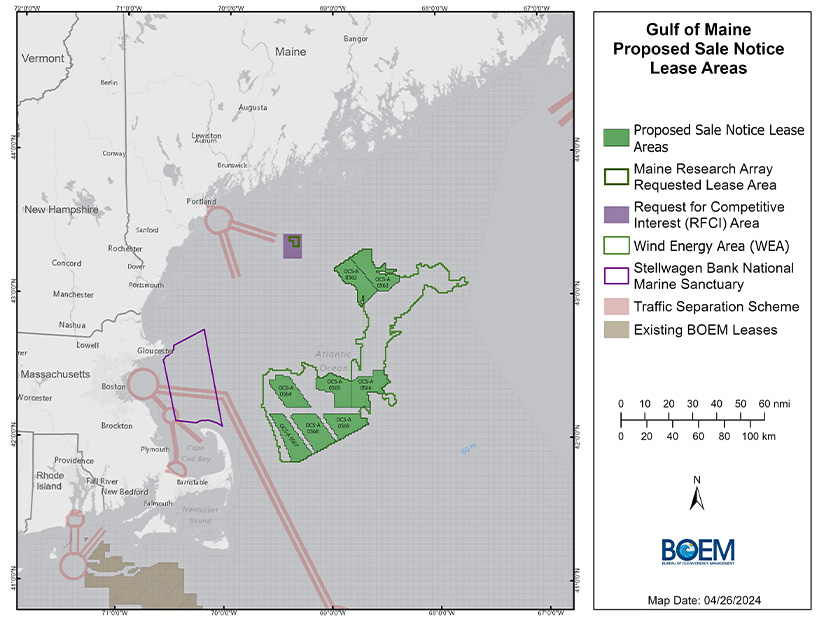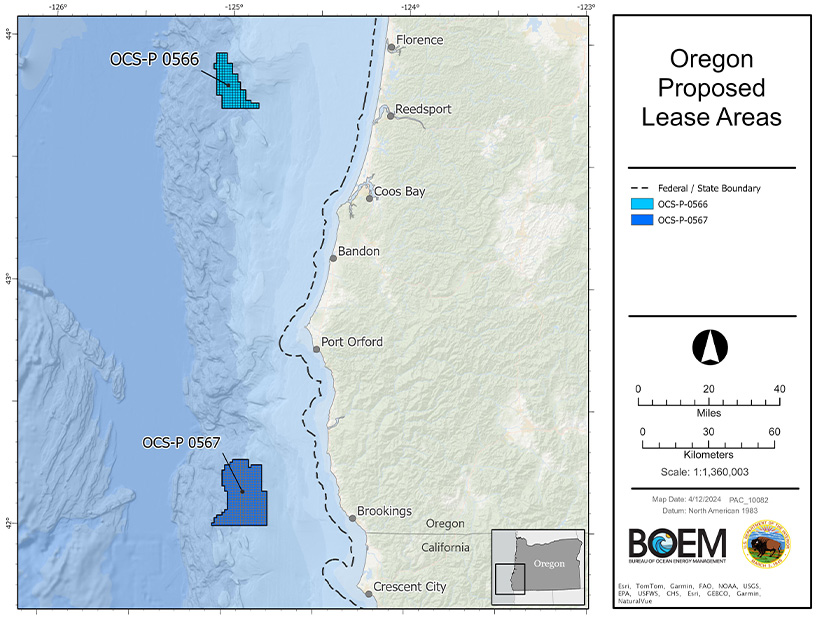
Federal regulators are moving ahead with plans to auction wind energy leases with a potential 18-GW capacity off the coasts of Oregon and northern New England.
The U.S. Bureau of Ocean Energy Management announced the plans April 30 and is seeking comment on the details before finalizing what would be the first such auctions in either location.
BOEM earlier this year finalized wind energy areas in both locations. (See BOEM Designates Gulf of Maine Wind Energy Area and BOEM Designates Wind Energy Areas off Oregon Coast.) This latest action identifies potential leases within those areas.
Most of the capacity identified in this plan is in the Gulf of Maine, where eight wind energy areas totaling nearly 1 million acres hold the potential for 15 GW of electrical generation.
The southern New England coast is the site of heavy wind energy development efforts, with one utility-scale offshore wind farm completed recently, a second under construction, a third about to begin construction and others seeking to rebound from economic setbacks that have delayed construction.
The water there is shallow enough that wind turbines can be installed with conventional fixed-bottom tower foundations. The Gulf of Maine is so deep in most places that wind energy development there would rely on floating turbine technology, which only recently is being used at scale worldwide.
Maine is attempting to position itself as an early leader in the floating wind industry, with research programs at the state university and an application with BOEM to place a floating research array off the central coastline. (See Maine One Step Closer to OSW Research Lease.)
The eight potential commercial lease areas BOEM identified April 30 are farther south in the Gulf of Maine, most of them closer to New Hampshire or Massachusetts than to Maine.
Speaking at the International Partnering Forum — Oceantic Network’s offshore wind conference April 22-25 — Maine Gov. Janet Mills (D) announced her state has begun the process to procure up to 3 GW of offshore wind energy by 2040. The state issued a Request For Information on April 24 to shape this process.
Floating wind technology will be needed along the Oregon coast, as well, due to water depths there. BOEM is considering adding lease stipulations that would award bid credits for bidders that commit to help develop the workforce and supply chain for the floating wind industry.
The two designated Oregon lease areas total nearly 200,000 acres and sit dozens of miles apart off the state’s southern and central coastline.
BOEM’s efforts to site offshore wind off Maine and Oregon have drawn opposition for their feared impact on commercial fishing. BOEM has made changes to draft proposals based on feedback from fishers and other stakeholders, and it said April 30 it would continue to consider their opinions.
“As we move forward with offshore wind energy in Oregon and the Gulf of Maine, the Bureau of Ocean Energy Management remains dedicated to close collaboration with our government partners and key stakeholders,” BOEM Director Elizabeth Klein said in the news release. “We’re excited to unveil these proposed sales and emphasize our commitment to exploring the potential for offshore wind development from coast to coast.”
Oceantic CEO Liz Burdock said in an April 30 news release:
“BOEM’s combined announcement solidifies two new regional markets for floating offshore wind, balancing the development of this industry sector across both coasts. New lease areas in Oregon will support a further buildout of the West Coast’s regional supply chain, adding strength to California projects. And in the Gulf of Maine, this new 15-GW potential will drive the creation of a floating offshore wind supply chain on the East Coast.”


